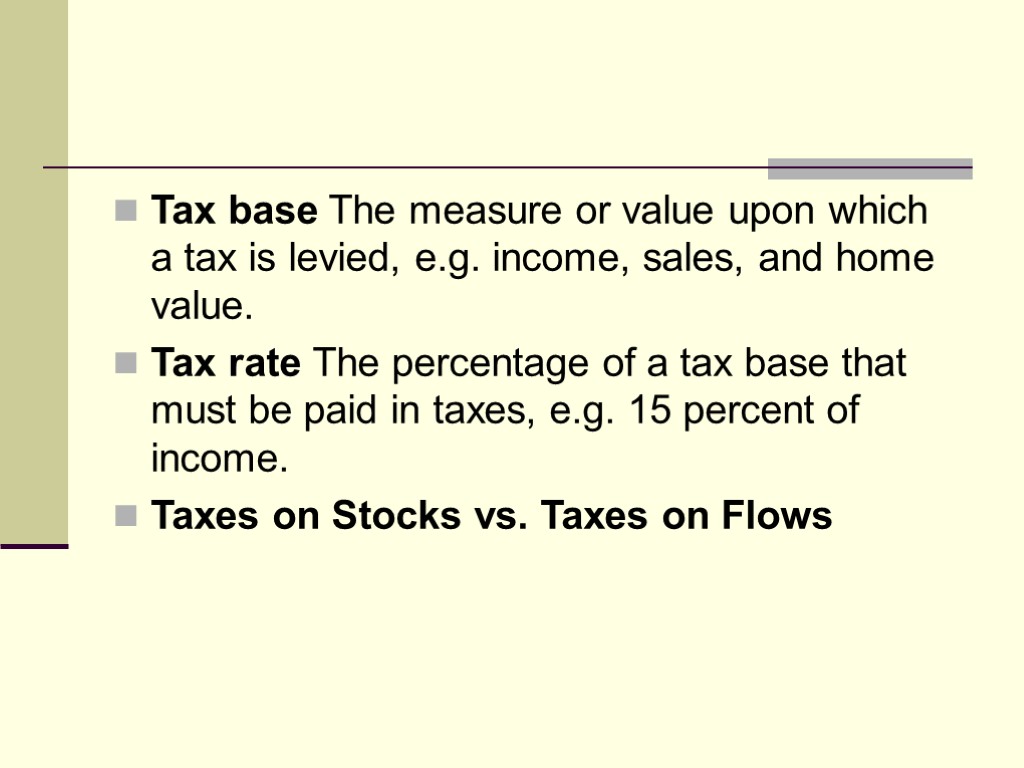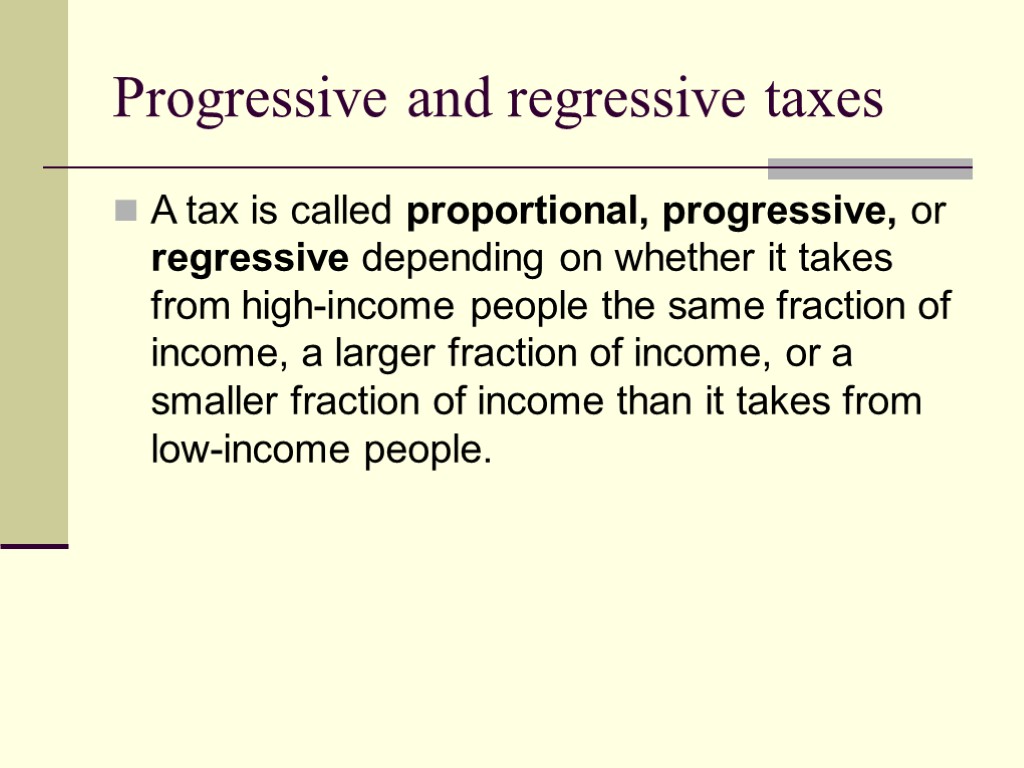Government in the Macroeconomy: Fiscal Policy. What is

















fiscal_policy_add.ppt
- Количество слайдов: 16
 Government in the Macroeconomy: Fiscal Policy
Government in the Macroeconomy: Fiscal Policy
 What is fiscal policy? Fiscal policy The taxing and spending tools that the government can use to influence the macroeconomy, specifically: tax rates, government purchases of goods and services, and transfer payments. Using these tools, the government attempts to influence the level of output, the composition of output, the price level, the unemployment rate, and so on.
What is fiscal policy? Fiscal policy The taxing and spending tools that the government can use to influence the macroeconomy, specifically: tax rates, government purchases of goods and services, and transfer payments. Using these tools, the government attempts to influence the level of output, the composition of output, the price level, the unemployment rate, and so on.
 The government’s budget It is enormously complicated document providing in a great detail a list of all the things the government plans to spend money on and all the sources of government revenues. In fact, “the budget” is really three different budgets. First, it is a political document that dispenses largess or favors to certain groups or regions and places burdens (taxes) on others. Second, it is a reflection of certain goals the government wants to achieve. Finally, the budget may be an embodiment of some beliefs about how (if at all) the government should manage the macroeconomy.
The government’s budget It is enormously complicated document providing in a great detail a list of all the things the government plans to spend money on and all the sources of government revenues. In fact, “the budget” is really three different budgets. First, it is a political document that dispenses largess or favors to certain groups or regions and places burdens (taxes) on others. Second, it is a reflection of certain goals the government wants to achieve. Finally, the budget may be an embodiment of some beliefs about how (if at all) the government should manage the macroeconomy.
 The budget: surplus, deficit A surplus results when the government takes in more than it spends during a given period; revenues minus expenditures is a positive number. A deficit results when the government spends more than it takes in during a given period; revenues minus expenditures is a negative number.
The budget: surplus, deficit A surplus results when the government takes in more than it spends during a given period; revenues minus expenditures is a positive number. A deficit results when the government spends more than it takes in during a given period; revenues minus expenditures is a negative number.
 Two major principles for organizing a tax system: The benefit principle, which holds that individuals should be taxed in proportion to the benefit they receive from government programs. Just as people pay private dollars in proportion to their consumption of private bread, a person’s taxed should be related to his or her use of collective goods like public road or parks. The ability-to-pay principle, which states that the amount of taxes people pay should relate to their income or wealth. The higher the wealth or income, the higher the taxes. Usually tax systems organized along the ability-to-pay principle are also redistributive, meaning that they raise funds from higher-income people to increase the incomes and consumption of poorer groups.
Two major principles for organizing a tax system: The benefit principle, which holds that individuals should be taxed in proportion to the benefit they receive from government programs. Just as people pay private dollars in proportion to their consumption of private bread, a person’s taxed should be related to his or her use of collective goods like public road or parks. The ability-to-pay principle, which states that the amount of taxes people pay should relate to their income or wealth. The higher the wealth or income, the higher the taxes. Usually tax systems organized along the ability-to-pay principle are also redistributive, meaning that they raise funds from higher-income people to increase the incomes and consumption of poorer groups.
 Tax base The measure or value upon which a tax is levied, e.g. income, sales, and home value. Tax rate The percentage of a tax base that must be paid in taxes, e.g. 15 percent of income. Taxes on Stocks vs. Taxes on Flows
Tax base The measure or value upon which a tax is levied, e.g. income, sales, and home value. Tax rate The percentage of a tax base that must be paid in taxes, e.g. 15 percent of income. Taxes on Stocks vs. Taxes on Flows
 Progressive and regressive taxes A tax is called proportional, progressive, or regressive depending on whether it takes from high-income people the same fraction of income, a larger fraction of income, or a smaller fraction of income than it takes from low-income people.
Progressive and regressive taxes A tax is called proportional, progressive, or regressive depending on whether it takes from high-income people the same fraction of income, a larger fraction of income, or a smaller fraction of income than it takes from low-income people.
 Direct and Indirect Taxes Indirect taxes are ones that are levied on goods or services and thus only “indirectly” on individuals. Examples: sales taxes, tariff on imports, property taxes Direct taxes are levied directly upon individuals or firms. Examples: personal income taxes, social security taxes, gift taxes
Direct and Indirect Taxes Indirect taxes are ones that are levied on goods or services and thus only “indirectly” on individuals. Examples: sales taxes, tariff on imports, property taxes Direct taxes are levied directly upon individuals or firms. Examples: personal income taxes, social security taxes, gift taxes
 How the State of the Economy Influences the Deficit? Fiscal Drag The negative effect on the economy that results when average tax rates increase because taxpayers have moved into higher income brackets during an expansion, or an inflation. Automatic stabilizers Revenue and expenditure items in the government’s budget that automatically change with the state of the economy: tax revenues that rise during an expansion, and expenditures for transfers that fall.
How the State of the Economy Influences the Deficit? Fiscal Drag The negative effect on the economy that results when average tax rates increase because taxpayers have moved into higher income brackets during an expansion, or an inflation. Automatic stabilizers Revenue and expenditure items in the government’s budget that automatically change with the state of the economy: tax revenues that rise during an expansion, and expenditures for transfers that fall.
 The actual budget records the actual dollar expenditures, revenues, and deficits in a given period. The structural budget calculates what government revenues, expenditures, and deficits would be if the economy were operating at potential output. The cyclic budget is the difference between the actual budget and the structural budget. It measures the impact of the business cycle on the budget, taking into account the effect of the cycle on revenues, expenditures, and deficits.
The actual budget records the actual dollar expenditures, revenues, and deficits in a given period. The structural budget calculates what government revenues, expenditures, and deficits would be if the economy were operating at potential output. The cyclic budget is the difference between the actual budget and the structural budget. It measures the impact of the business cycle on the budget, taking into account the effect of the cycle on revenues, expenditures, and deficits.
 Government debt Government debt The total amount of outstanding government securities held by the public.
Government debt Government debt The total amount of outstanding government securities held by the public.
 The Reasons of Occurrence of a Government Debt: expenses during wars; cyclical contraction; tax decrease.
The Reasons of Occurrence of a Government Debt: expenses during wars; cyclical contraction; tax decrease.
 The Volume of Government Debt In 1988 the Government Debt of USA = $2600 billions or $2,6 trillions. $2,6 trillions in denomination of $1 = 240 million miles i.e. distance from the Earth up to the Sun and back. debt and GNP; interest rates payments; property;
The Volume of Government Debt In 1988 the Government Debt of USA = $2600 billions or $2,6 trillions. $2,6 trillions in denomination of $1 = 240 million miles i.e. distance from the Earth up to the Sun and back. debt and GNP; interest rates payments; property;
 How the government debt can influence on economic activity? May it lead to the bankruptcy of the nation? May it be the burden for our future generation? Refinancing of government debt - the situation when the government sells new bonds and money received uses for payments to bonds holders; Taxation Creation of money
How the government debt can influence on economic activity? May it lead to the bankruptcy of the nation? May it be the burden for our future generation? Refinancing of government debt - the situation when the government sells new bonds and money received uses for payments to bonds holders; Taxation Creation of money
 Problems related to government debt: Payments of interest rates for government debt increase the income inequality; Payments of interest rates for government debt require the increase of taxes, which can undermine action of economic stimulus; Payments of interest rates or the basic sum of debt lead to transference of the certain share of real product abroad; Loans by the government on the capital market for refinancing government debt or to pay percents, can increase interest rate and supersede (витіснити) private investment financing.
Problems related to government debt: Payments of interest rates for government debt increase the income inequality; Payments of interest rates for government debt require the increase of taxes, which can undermine action of economic stimulus; Payments of interest rates or the basic sum of debt lead to transference of the certain share of real product abroad; Loans by the government on the capital market for refinancing government debt or to pay percents, can increase interest rate and supersede (витіснити) private investment financing.
 Methods of Decreasing the Deficit and Government Debt in 80- ties The constitutional amendments legislatively establishing annually balanced budget; The specified law of Gram – Rudman- Hollings, which requires annual reduction of deficits till the moment of achievement of the balanced budget in 1993; Offers on an establishment of new federal taxes or introduction of higher rates of operating taxes; Strengthening of privatization of economy by sale of the state assets and programs in a private sector; Giving to the president the right of the veto on terms and clauses of budgetary charges.
Methods of Decreasing the Deficit and Government Debt in 80- ties The constitutional amendments legislatively establishing annually balanced budget; The specified law of Gram – Rudman- Hollings, which requires annual reduction of deficits till the moment of achievement of the balanced budget in 1993; Offers on an establishment of new federal taxes or introduction of higher rates of operating taxes; Strengthening of privatization of economy by sale of the state assets and programs in a private sector; Giving to the president the right of the veto on terms and clauses of budgetary charges.

